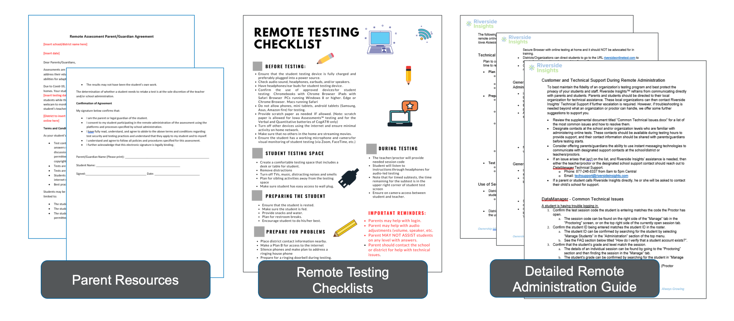Riverside's Readiness for COVID-19
We're Here to Support You.
Although the situation with COVID-19 continues to evolve, our commitment to our customers remains unchanged. Click the image above to request access to remote administration guidelines and other resources for our K-12 Ability, Achievement, and RTI assessments. You can also learn more here about the general steps Riverside Insights has taken to mitigate risk and ensure that our teams, our fulfillment and data centers, and our services can continue to support you without interruption.
Your business and the safety and health of our employees are our top priorities, and we will continue to evaluate our people, processes, and services to ensure we’re doing everything we can to support you through this evolving situation. If you have any questions, please don’t hesitate to reach out to us at COVID-readiness@riversideinsights.com, and make sure to check out our Frequently Asked Questions below.
One important consideration for testing interruptions is when to resume testing. Similar to the “summer effect,” students may take a week or more to settle back into the classroom routine once school resumes after an extended break. Although completing your testing may be a priority, we recommend that you do not resume testing until students have had enough time to adjust to being back in the classroom.
If your online Test Event automatically closed while students were away, you can reopen and resume testing when you are ready. If testing had barely started when your program was interrupted, you can zero out any completed subtests and give all students the opportunity to start over.
Additionally, educators have expressed concerns about the effect of testing interruptions on normative scores. The grade-based scores for the Iowa Assessments, Logramos, and CogAT are reported based on Fall, Midyear, or Spring normative data. The effective date of scoring is determined by the Test Event date for online testing or the date specified on the Order for Scoring Services (OSS) for paper and pencil tests submitted to Riverside Scoring Service. Testing dates from March 1st to July 31st are scored using Spring normative data. Scoring tests using any date between March 1st to July 31st will result in the same spring norms being applied, so any delays in your testing program will not impact the interpretability of grade-based scores.
The age-based scores for CogAT are reported in one-month age intervals. For instance, a student born anytime in October 2011 and scored using an April 2020 effective date of scoring will be scored using an age of 8 years, 6 months. Shifting the scoring date back to March results in the student being scored with an age of 8 years, 5 months; shifting the scoring date ahead to May scores the student with an age of 8 years, 7 months.
In most cases, it will not be advisable to shift the effective date of scoring for your CogAT testing. A one or two month shift in the date of scoring will have a negligible impact on most students’ age scores. Additionally, maintaining an earlier date in scoring gives students the greatest benefit, because expectations for performance are higher the greater the student’s age when scored. The exception is when little to no testing occurred before the interruption. If at least half of your students finished their CogAT testing prior to the interruption, we recommend maintaining the original effective testing date of scoring.
For paper and pencil testing, specify the most reasonable midpoint for your extended testing window on your OSS when shipping documents for scoring. You may want to adjust the date depending on whether most of the testing was conducted prior to or after the interruption to your testing program.
The CogAT Screening Form and Post-Screener present a special circumstance for testing interruptions. To maintain integrity in scoring, the online Test Event dates for the Screening Form and Post-Screener must be within a 30-day window. However, this does not mean that the testing must occur within 30 days. Testing may extend for a few weeks on either side of the Test Event date itself without affecting students’ scores.
If the gap in administering the Screening Form and Post-Screener is more than two months, the Post Screener is not recommended. The best option is to administer the full CogAT, including all nine subtests, instead of the Post Screener.
Students’ scores on the Screening Form are based on the Screening Form Test Event date; the complete CogAT scores from the Post-Screener are based on the Post-Screener Test Event date. For instance, a student born any time in October 2011 and scored in a March 2020 Test Event will be scored using an age of 8 years, 5 months. If the Post-Screener Test Event is dated April 2020, the student’s complete CogAT is scored using an age of 8 years, 6 months. Please note that a one or two month shift in the date of scoring will have a negligible impact on most students’ age scores. Additionally, maintaining an earlier date in scoring gives students the greatest benefit, because expectations for performance are higher the greater the student’s age when scored.
Backdating your Post-Screener Test Event by one or two months maintains the integrity of your Screening Form scores and will not adversely affect students’ scores on the complete CogAT resulting from Post-Screener administration. For example, although you might administer the Post-Screener in May, you could backdate the Post-Screener Test Event to an April date to stay within the 30-day window. However, a gap of three or more months in the Post-Screener Test Event date and the actual administration of the Post-Screener will results in scores which may be artificially high and will be difficult to interpret with fidelity.
For regular administrations, the best practice is to set your Screening Form Test Event date toward the end of your screening testing window and set your Post-Screener Test Event date earlier in your Post-Screener testing window to provide the most flexibility in your testing schedule. For instance, a Test Event date set any day in March, from the 1st to the 31st, results in the students’ ages being calculated relative to the month of March. Setting your Screening Form Test Event date as March 31 calculates the students’ ages the same as if your Test Event date were March 1 – but you then have an additional 30 days to schedule your Post-Screener (up to April 30, instead of April 1).
Additionally, setting up your Post-Screener Test Event in advance is a best practice that helps to ensure that you do not miss the 30-day window. If you missed the 30-day window due to an unplanned testing program interruption, the DataManager Support Center can assist you with opening a Post-Screener Test Event backdated up to 60 days to ensure that your students will have the opportunity to complete testing using the Post-Screener. Test Event dates cannot be backdated more than 60 days.
If the gap in administering the CogAT Screening Form and Post-Screener is more than two months, the Post-Screener is not recommended. A gap of three or more months in the Post-Screener Test Event date and the actual administration of the Post-Screener will result in scores which may be artificially high and will be difficult to interpret with fidelity. The best option is to administer the full CogAT, including all nine subtests, instead of the Post-Screener. If you were not able to open a Post-Screener Test Event within the backdated 60-day window, please contact Riverside Customer Service (800-323-9540) for assistance.
If your students were testing online and did not get to complete the test, please contact Riverside Customer Service (800-323-9540), and they can assist you so that your students can start over.
We are closely monitoring the school closure situation across the United States. As more schools evaluate options for distance learning, we will evaluate best practices for assessment that support changes to the teaching and learning process.
Yes, but please review the section on testing interruptions above and consider the 'summer effect' that occurs when there is an extended break in schooling.
Your longitudinal data will still trend to measure student growth and progress over time. The robust vertical scale underlying the Iowa Assessments and Logramos enables score comparisons over varied periods of time including within and between school years, as well as across multiple school years.
If your planned spring testing was cancelled, the best practice is to test students upon their return to school in the fall. This will enable teachers to more effectively plan instruction and make program placements once school resumes while also maintaining your longitudinal data. For this fall administration, you might choose to use the test level that students would have taken the previous spring. As National Percentile Ranks (NPR) are affected by norming periods, please see the next section for information if you choose to test in the fall with spring information. National Standard Scores (NSS) and Grade Equivalents (GE) can also be used to track longitudinal progress. You can return to your normal testing schedule with students testing again the following spring with no ill effect to your longitudinal trend.
Scoring students as if they were tested the previous spring at a lower grade level will result in higher National Percentile Rank (NPR) scores than using Fall NPRs for the next higher grade. For example, if incoming Grade 2 students are scored with Grade 1 Spring norms, the percentile rank scores will be higher than if they are scored using Grade 2 Fall norms. National Standard Scores (NSS) and Grade Equivalents (GE) will not be affected by this switch in norming periods.
If you elect to adjust scoring in this way, you must be careful to choose a scoring date (or online Test Event date) prior to August 1, 2020. Additionally, roster files, document coding, and/or student barcodes should reflect the previous grade – for example, indicating Grade 1 for incoming Grade 2 students.
Online licenses for the Iowa Assessments, Logramos, and CogAT purchased prior January 1st, 2020 have been extended for use through December 31st, 2020. This provides you more opportunity to test students in the fall who may have missed testing this spring. All online test administrations purchased after January 1st, 2020 are already available for use through June 30th, 2021.
Customer license balances in DataManager will reflect the adjusted date of December 31, 2020 by May 1st.
For Schools Affected by COVID-19 Closures
Please refer to this complimentary webinar recording for information on how to change planned test events in light of unexpected closures.
- Changing a DataManager Test Event When a School Closes Unexpectedly
- 3 Things You Can Do Right Now with CogAT Data
Other Complimentary Professional Development and Learning Opportunities
We remain committed to your ongoing professional learning and development. Join us for our virtual Insights Sessions:



